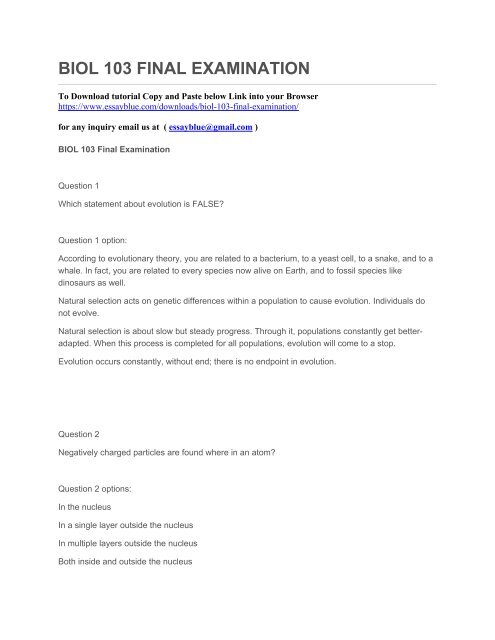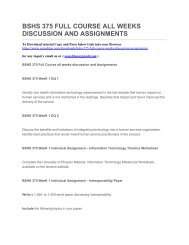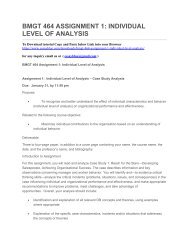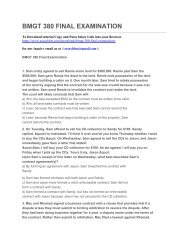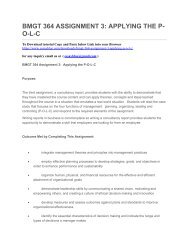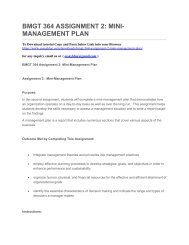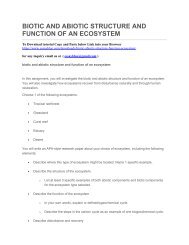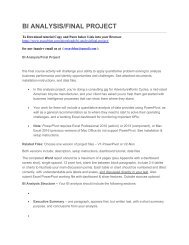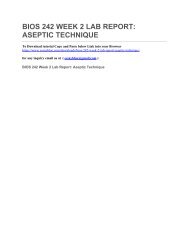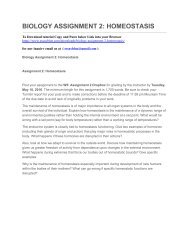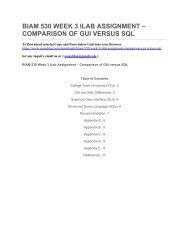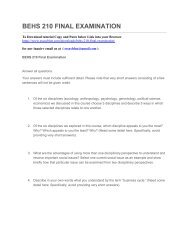BIOL 103 FINAL EXAMINATION
Create successful ePaper yourself
Turn your PDF publications into a flip-book with our unique Google optimized e-Paper software.
<strong>BIOL</strong> <strong>103</strong> <strong>FINAL</strong> <strong>EXAMINATION</strong><br />
To Download tutorial Copy and Paste below Link into your Browser<br />
https://www.essayblue.com/downloads/biol-<strong>103</strong>-final-examination/<br />
for any inquiry email us at ( essayblue@gmail.com )<br />
<strong>BIOL</strong> <strong>103</strong> Final Examination<br />
Question 1<br />
Which statement about evolution is FALSE?<br />
Question 1 option:<br />
According to evolutionary theory, you are related to a bacterium, to a yeast cell, to a snake, and to a<br />
whale. In fact, you are related to every species now alive on Earth, and to fossil species like<br />
dinosaurs as well.<br />
Natural selection acts on genetic differences within a population to cause evolution. Individuals do<br />
not evolve.<br />
Natural selection is about slow but steady progress. Through it, populations constantly get betteradapted.<br />
When this process is completed for all populations, evolution will come to a stop.<br />
Evolution occurs constantly, without end; there is no endpoint in evolution.<br />
Question 2<br />
Negatively charged particles are found where in an atom?<br />
Question 2 options:<br />
In the nucleus<br />
In a single layer outside the nucleus<br />
In multiple layers outside the nucleus<br />
Both inside and outside the nucleus
Question 3<br />
You have a solution that has a pH of 8 and need it to be pH 5. What do you do?<br />
Question 3 options:<br />
Add water<br />
Add a base<br />
Add an acid<br />
Add a buffer<br />
Question 4<br />
What characteristic of carbon makes it a good backbone for creating diverse and durable<br />
molecules?<br />
Question 4 options:<br />
Carbon is a large atom.<br />
Carbon forms four covalent bonds.<br />
Carbon forms hydrogen bonds.<br />
All of the above<br />
Question 5<br />
Which of the following structures can be found together in eukaryotic cells?
Question 5 options:<br />
cytoplasm and ribosomes<br />
cytoplasm and plasma membrane<br />
DNA and ribosomes<br />
ribosomes and endoplasmic reticulum<br />
Question 6<br />
Which of the following reactions or pathways is catabolic?<br />
Question 6 options:<br />
Breaking down ATP into ADP and phosphate.<br />
Making starch from many glucose molecules.<br />
Photosynthesis: which builds glucose from carbon dioxide using energy from light.<br />
Making ATP from ADP and Phosphate.<br />
Question 7<br />
In a metabolic pathway, a typical control mechanism is to have: ________<br />
Question 7 options:<br />
the final product have no effect on the enzyme responsible for its own production.<br />
the final product inhibit an early step.<br />
a reactant inhibit a late step.<br />
a lack of reactant stimulate the pathway.
Question 8<br />
Mitosis results in ______ cells and meiosis results in _______ cells.<br />
Question 8 options:<br />
haploid, diploid<br />
diploid, haploid<br />
diploid, diploid<br />
haploid, haploid<br />
Question 9<br />
In beans yellow (Y) is dominant to green (y) and smooth (S) is dominant to wrinkled (s). What are<br />
the possible genotypes for the offspring of the following cross: YySS and YYSs.<br />
Question 9 options:<br />
YYSS, YYss, yySS, yyss<br />
YS, yS, YS, yS<br />
Yy, SS, YY, Ss<br />
YYSS, YySS, YYSs, YySs<br />
Question 10<br />
Red rose color is incompletely dominant over white rose color. If a red rose is crossed with a pink<br />
rose, what percentage of the offspring will be pink?<br />
Question 10 options:
100<br />
75<br />
50<br />
25<br />
Question 11<br />
One of the products of cellular respiration is ________.<br />
Question 11 options:<br />
water<br />
sucrose<br />
cellulose<br />
oxygen<br />
Question 12<br />
An ecologist is studying all the animals, plants, fungi and bacteria, as well as the interaction among<br />
them, in a forest? He is studying the _________ in the forest.<br />
Question 12 options:<br />
niche<br />
biome<br />
community<br />
population
Question 13<br />
The temperature optimum for an enzyme is 37C. What will most likely happen if you increase the<br />
temperature from 37C to 50C?<br />
Question 13 options:<br />
The enzyme activity will not be affected<br />
The enzyme activity will increase<br />
The enzyme activity will decrease<br />
The pH will increase<br />
Question 14<br />
When celery is placed in a glass of pure water the solution inside its cells is _____ compared to the<br />
water.<br />
Question 14 options:<br />
selectively permeable<br />
isotonic<br />
hypertonic<br />
hypotonic<br />
Question 15<br />
An ecosystem can be characterized as:<br />
Question 15 options:
populations + community.<br />
all species, population, and community interactions for organisms in a given area.<br />
the abiotic components of the environment.<br />
all of the biological interactions, plus interactions with the abiotic environment, in a given area.<br />
Question 16<br />
Enzymes<br />
Question 16 options:<br />
catalyze reactions<br />
prevent reactions from occurring<br />
are found only in prokaryotes<br />
all of those answers are correct<br />
Question 17<br />
This term refers to the maintenance of internal stability in a creature:<br />
Question 17 options:<br />
homeostasis<br />
mutualism<br />
parasitism<br />
meiosis
Question 18<br />
Steroids and waxes are<br />
Question 18 options:<br />
proteins<br />
carbohydrates<br />
lipids<br />
nucleic acids<br />
Question 19<br />
Active transport DOES NOT require ATP<br />
Question 19 options:<br />
True<br />
False<br />
Question 20<br />
In October of 2003, a raging wildfire swept through the mountain ecosystems in Southern California,<br />
burning everything in its path to the ground and driving away all of the animals. In order for the<br />
mountain ecosystem to re-establish itself, which member of the food web has to return first?<br />
Question 20 options:<br />
deer<br />
coyotes<br />
snake
grasses<br />
Question 21<br />
Carbohydrates are not<br />
Question 21 options:<br />
stored potential energy<br />
made mostly of nitrogen and carbon.<br />
broken down by cellular respiration.<br />
made by producers.<br />
Question 22<br />
A primary consumer would eat:<br />
Question 22 options:<br />
secondary consumers<br />
plants.<br />
Bacteria.<br />
rabbits.<br />
Question 23<br />
Diffusion is
Question 23 options:<br />
One type of active transport<br />
The movement of water across the cell membrane<br />
The movement of molecules from an area of low concentration to an area of high concentration<br />
The movement of molecules from an area of high concentration to an area of low concentration<br />
Question 24<br />
Any individual organism has the potential to adapt to its environment, if it is given enough time and<br />
possesses a mechanism to generate variation.<br />
Question 24 options:<br />
True<br />
False<br />
Question 25<br />
Once an adaptation appears, it remains in all the descendants unless the species becomes extinct<br />
Question 25 options:<br />
True<br />
False<br />
Question 26
When a founder population has a small gene pool, evolutionary change is more likely to be rapid<br />
than if the founder population has a large gene pool.<br />
Question 26 options:<br />
True<br />
False<br />
Question 27<br />
When speciation occurs, the result is a huge dramatic change in the new species.<br />
Question 27 options:<br />
True<br />
False<br />
Question 28<br />
When two groups are reproductively isolated, it can be reliably predicted that speciation will follow<br />
very soon.<br />
Question 28 options:<br />
True<br />
False<br />
Question 29
Codons are locate on<br />
Question 29 options:<br />
abiotic components<br />
DNA<br />
RNA<br />
all of those<br />
Question 30<br />
Fossil evidence suggests that human ancestors arose one time in Africa.<br />
Question 30 options:<br />
True<br />
False<br />
Question 31<br />
Sunlight influences vitamin D production is humans.<br />
Question 31 options:<br />
True<br />
False<br />
Question 32
Mitochondria and chloroplasts of eukaryotic cells are very similar to prokaryotes<br />
Question 32 options:<br />
True<br />
False<br />
Question 33<br />
Organisms that live in habitats with high levels of competition are more likely to produce defensive<br />
chemicals than those that live with little competition.<br />
Question 33 options:<br />
True<br />
False<br />
Question 34<br />
The human population may continue to increase even though it surpasses carrying capacity.<br />
Question 34 options:<br />
True<br />
False<br />
Question 35<br />
A woman’s ovum will complete Meiosis II only, if fertilization has occurred.
Question 35 options:<br />
True<br />
False<br />
Question 36<br />
One human disease is caused by a change in the DNA from GAA to GTA. This change is an<br />
example of:<br />
Question 36 options:<br />
crossing over<br />
a mutation<br />
independent assortment<br />
cytokinesis<br />
Question 37<br />
The main function of a ribosome is to ____________________.<br />
Question 37 options:<br />
extract energy from glucose<br />
synthesize glucose<br />
store food in the form of fat<br />
synthesize proteins
Question 38<br />
The effectiveness of a medication containing growth hormone is tested on a group of young male<br />
rabbits 3 weeks of age. The best control group would be:<br />
Question 38 options:<br />
any group of rabbits<br />
a group of young male rabbits 3 weeks of age, not given the medication<br />
a group of young female rabbits 3 weeks of age, not given the medication<br />
no control is required; just measure whether the rabbits grew<br />
Question 39<br />
The number of _______________ in the outer shell of an atom determines the type of chemical<br />
bonds an atom can make.<br />
Question 39 options:<br />
electrons<br />
protons<br />
ions<br />
neutrons<br />
Question 40<br />
You find a cell of a type you have never seen before. The cell has both a nucleus and a cell wall.<br />
Therefore, you conclude, it must be a _______________ cell.<br />
Question 40 options:
liver<br />
animal<br />
bacterial<br />
plant<br />
Question 41<br />
The gene pool of a population may change due to:<br />
Question 41 options:<br />
migration<br />
genetic drift<br />
natural selection and mutation<br />
all of the above<br />
Question 42<br />
What are “keystone species” in a community?<br />
Question 43<br />
What is “pseudoscience”?<br />
Question 44
What are dependent variables?<br />
Question 45<br />
(Required) You have read that inorganic fertilizers contribute to water pollution and would like to<br />
make a switch from inorganic fertilizers to organic compost in your vegetable garden. A friend<br />
graciously gives you a truck load of his compost. As a good researcher and critical thinker you are<br />
not convinced that organic compost will yield better results than the inorganic fertilizer you have<br />
used for years with good results. To draw your own conclusion based on scientific evidence you<br />
decide to conduct an experiment in your garden. State a good hypothesis, design an experiment<br />
(include test subjects, sample size, control(s), dependent and independent variables, type of data<br />
collected) and hypothetical results/conclusion. Does your conclusion support the hypothesis?<br />
Question 46<br />
(Required) The habitat of one species of tropical fish is red coral reefs. The large majority of the<br />
fish in this population are red. A few individual fish carry a mutation that prevents the production of<br />
the red pigment; as a result these individual fish are white.The temperature of the ocean where<br />
these fish live gets warmer and warmer over a 10 year period, and as a result the coral is bleached<br />
and turns white. Use what you have learned about natural selection to explain how this bleaching<br />
event may have affected the evolution this fish population (not including possible direct effects of<br />
warmer temperatures on the fish). Use appropriate terminology about evolution in your answer,<br />
including the terms natural selection, adaptive trait, and reproductive success.<br />
Question 47<br />
Describe the major land biome where you live. How have human activities affected native species?<br />
Include specific examples.<br />
Question 48
You scoop up a water sample from a local pond nearby, because you are curious about the possible<br />
microbes that might live there. After looking at several slides that held drops of the sample, you<br />
noticed two different kinds of cells: One kind was very small and had no separate internal structures;<br />
the other kind was much larger, and it contained several kinds of internal structures that were<br />
physically different from each other. Please name each cell and briefly describe their similarities and<br />
difference


